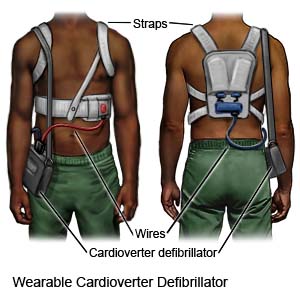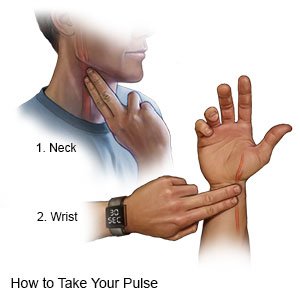Wearable Cardioverter Defibrillator
Medically reviewed by Drugs.com. Last updated on Sep 23, 2025.
A WCD is a vest with a small monitor. The vest contains electrodes, or pads, that can shock your heart if the monitor detects a life-threatening arrhythmia. An arrhythmia is an irregular heart rate. An arrhythmia may cause your heart to suddenly stop beating effectively. A WCD can give a shock to your heart to make it start beating effectively again.
 |
DISCHARGE INSTRUCTIONS:
Call 911 or have someone else call 911 for any of the following:
- You have any of the following signs of a heart attack:
- Squeezing, pressure, or pain in your chest
- You may also have any of the following:
- Discomfort or pain in your back, neck, jaw, stomach, or arm
- Shortness of breath
- Nausea or vomiting
- Lightheadedness or a sudden cold sweat
- You become weak, dizzy, or faint.
- You have trouble breathing.
- You lose consciousness.
Seek care immediately if:
- You feel 1 or more shocks from your WCD.
- Your monitor will not turn on.
Contact your healthcare provider if:
- You have a fever.
- Your feet or ankles swell.
- You are sad or anxious and find it hard to do your usual activities.
- You have questions or concerns about your condition or care.
Medicines:
Heart medicine may be given to strengthen or control your heartbeat. Call your provider if you think your medicine is not helping or if you have side effects. Tell him or her if you are allergic to any medicine. Keep a list of the medicines, vitamins, and herbs you take. Include the amounts, and when and why you take them. Bring the list or the pill bottles to follow up visits. Carry your medicine list with you in case of an emergency.
Related medications
How a WCD works:
- The electrodes, or pads, are located inside of the vest. They will rest against your skin when you put on the vest. The electrodes are attached to the monitor by a wire. The monitor can be worn on your belt or a shoulder strap. Four electrodes will continuously monitor your heart rate and rhythm and send information to the monitor. If the monitor detects an arrhythmia, it will send a shock to your heart through 3 defibrillator electrodes. Your monitor will display and record all the activity of your heart, including any arrhythmia and shocks. You may be able to send this information through a wireless signal to your provider. He or she may use this information to change your medicines or decide if you need other treatment.
- If you have a life-threatening arrhythmia or your heart stops beating, you will not be awake. If you are awake and your monitor vibrates or alarms that you have an arrhythmia, you will need to push a response button on the monitor. This button will prevent you from getting a shock when you do not need one. Your monitor may detect an arrhythmia when there is not one. This can happen if your belt is not worn correctly, or the electrodes are not touching your skin the right way. It can also happen when the electrodes sense your movements instead of your heart rate and rhythm.
- If you lose consciousness and are having a true arrhythmia, your WCD will shock your heart. The monitor will tell anyone who is nearby not to touch you. This is to prevent the person from also getting shocked. The monitor will tell the person to call 911. Your WCD will deliver shocks until the monitor detects a normal heart rhythm and rate.
Self-care:
- Wear your WCD at all times except for bathing. An arrhythmia can happen at any time. Do not swim with your WCD.
- Position your WCD as directed. Place the vest correctly around your chest and back. Change the length of the vest's straps so that the electrodes are making good contact with your skin. Ask your provider if it is okay to put lotions or powders on your skin. Ask your provider for more information about how to wear your WCD.
- Change the batteries as directed. Most batteries only last for 24 hours. Remove and replace the battery of your WCD as directed.
- Tell your friends or family how the WCD works. Tell your family members or friends not to push the response button if you lose consciousness. This may prevent you from getting a shock when you need one.
- Stay away from magnets or machines with electric fields. Ask your provider before you have an MRI. Some MRI machines may be safe to use with your WCD. Avoid leaning into a car engine or doing welding. These things can interfere with how your WCD works.
- Keep your cell phone and MP3 player away from your WCD. Do not keep your cell phone or MP3 player in your breast pocket. Ask your provider about how to safely use your cell phone and MP3 player with your WCD.
Learn how to take your pulse:
Check your pulse any time you feel lightheaded, dizzy, or short of breath. Use the second hand of a clock or a timer. Flip your hand with palms face up. Place your pointer finger and second finger onto the side of your wrist that is under your thumb. Apply gentle pressure. When you feel your pulse, count the number of beats in 15 seconds. Multiply this number by 4 to find the beats per minute. A normal pulse is 60 to 100 beats per minutes.
 |
Encourage your family and friends to learn CPR:
Talk to your family and friends about becoming certified in CPR. Some heart rhythms cannot be shocked by your WCD. CPR may be needed to save your life.
Follow up with your healthcare provider as directed:
Your provider may frequently check the recording of your heart's activity. Write down your questions so you remember to ask them during your visits.
© Copyright Merative 2025 Information is for End User's use only and may not be sold, redistributed or otherwise used for commercial purposes.
The above information is an educational aid only. It is not intended as medical advice for individual conditions or treatments. Talk to your doctor, nurse or pharmacist before following any medical regimen to see if it is safe and effective for you.
Further information
Always consult your healthcare provider to ensure the information displayed on this page applies to your personal circumstances.
